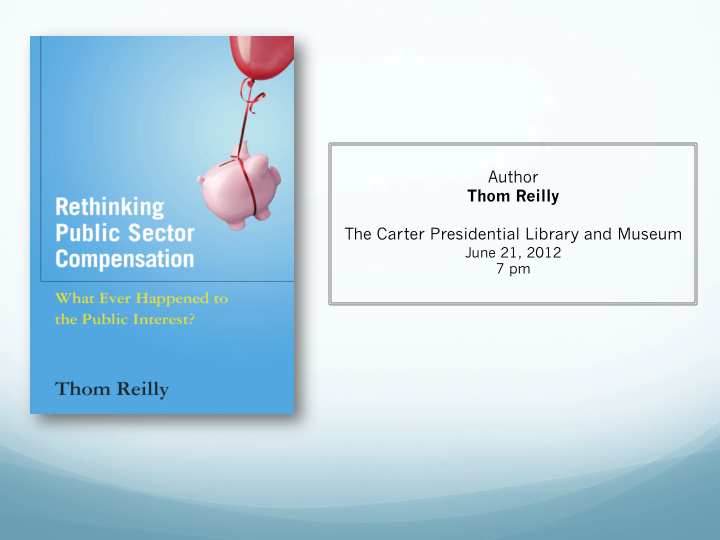



Author Thom Reilly The Carter Presidential Library and Museum June 21, 2012 7 pm
A Broken System The current way we Retiree Health reward and manage Care employees is skewed too heavily towards pensions and retiree Pensions health care. Public Employees
Public Employment Current system places too much emphasis on: Job Security Time Served Rather than: Performance Innovation Entrepreneurial Thinking
An Unsustainable System Creates significant challenges for: ü service delivery ü efficiency ü responsiveness
Employee Compensation Deferral of Future employee Generations compensation Shifts costs to With interest! Expensive and ethically troublesome Results in personnel system
Pensions Gone Wild! Estimates place the unfunded liability for pensions and retiree health care between $1 trillion and $3 trillion!
To put this in perspective if you stack a trillion $1 bills on top of each other, you can reach the moon and back, four times! *According to astrophysicist Neil deGrasse Tyson
The typical public pension plan assumes its investments will earn average annual returns of 8% over the long term 1 Actual experience since 2000 has been much less – 5.7% over the last 10 years 2 1 Center for Retirement Research at Boston College 2 National Association of State Retirement Administrators
State and Local Gov’t Accounting Rules Governments do not use their investment assumptions to project future asset growth Governments measure what they will owe future retirees, in today’s dollars Private companies have been prohibited from this doing since 1993
Recent Chapter 9 pension- related bankruptcies Vallejo, California – inability to pay pension obligations (2008) Prichard, Alabama – inability to pay pensions, especially state mandated increases (2009) Central Falls, Rhode Island – inability to pay obligations, especially pensions (2011)
Cities in California Exploring Bankruptcy Stockton – pop. 290,000 Hercules – pop. 26,000 Lincoln – pop. 43,248 Milpitas – pop. 66,790
States where pensions are running out of money State Pension Liability Percent of Pension Funded Kentucky $36 billion 58% Illinois $126 billion 51% New Hampshire $8 billion 58% New Jersey $135 billion 66% Oklahoma $35 billion 57% Kansas $21 billion 64% Massachusetts $61 billion 68% Colorado $55 billion 69% Maryland $53 billion 65%
Who’s to Blame?
The Iron Triangle Elected Politicians Gov’t Bureaucracies Interest Groups
Seniority Rules! Understanding the civil service system…
Public vs. Private Who really makes more?
Public vs. Private cont’d Public sector workers at all levels (federal, state, and local) earn higher wages and benefits than their private sector counterparts
Public vs. Private cont’d However, when comparisons of similar workers are made between the two with regards to education, age, and occupation, most studies show public workers are either modestly over or underpaid.
The Education Divide Most significant factor… Without college degrees, employees do better working for governments Public employees with college degrees do worse
Main Controversy How much to value deferred benefits such as: Pensions Retiree health care Job security
Lifetime Earning Blue-collar White-collar
(Public) Workers of the World Unite!
Standard Public employees should be compensated in a manner comparable to their private sector counterparts This is consistent with economic and efficiency principles and concepts of fairness and equality
Prescription for Reform Increased transparency Avoiding conflicts and self-dealing in awarding compensation Pensions and other post-employment benefits (OPEB) Raising retirement age Eliminating current abuses Increased employee contributions Moving employees to 401k-style or hybrid plans (portability) Moratorium on new benefits until plans are fully funded Fully fund pension and OPEB obligations Independent analysis of benefit costs that outline how the plans will be funded now and in the future Voter approvals of OPEB increases Retiree health care reform
Prescription for Reform cont’d Civil service reform At will employment Broadbanding Move away from time served compensation to rewarding employees for high performance, innovation and entrepreneurial thinking (bonus structure)
Prescription for Reform cont’d Collective bargaining compensation Subject collective bargaining to open meeting laws Right to work (prohibit compulsory union membership/dues) Prohibit strikes by public workers Do not subject certain deferred compensation benefits (i.e., pensions and retiree health care) to collective bargaining Community members/citizens appointed to collective bargaining teams In lieu of arbitration and when an impasse occurs, allow elected officials or the community to decide
Thank you for your time today! For more information, visit www.rethinkingpublicpay.com Contact info: thom@thereillygroup.org
Recommend
More recommend